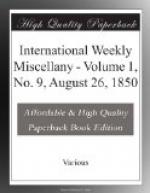We have said that the most instructive part of Herr Bodenstedt’s essay is his sketch of that politico-religious scheme which made Schamyl formidable to the Russians. This system, it is to be observed, arose and has since been fully developed only in the Eastern Caucasus, where of late the main stress of the war has been. The western tribes (our “Circassians”) who took the lead at an earlier stage of the contest, were not then, nor have they since been, inspired by the fanatic zeal which united the tribes of Daghestan. They fought from a mere love of independence, each little republic by itself; and their efforts, however heroic, being without concert, gradually declined before the vast force of the invader. In the region looking westward from the Georgian frontier on the Euxine, on the one side of the Caucasian range, and along the lower Kuban on the other, the Russian posts are now seldom threatened but by small predatory bands; the natives, retired to their mountain villages, have for some time made but few more formidable incursions. The war is transferred to the region spreading eastward from the Elbrus to the Caspian; where the strife for free existence is animated not less by the hatred of Russian slavery than by a fresh outbreak of Mohammedan zeal against infidel invasion,—a revival, in fact, of that war-like fanaticism which made the Moslem name terrible from the eighth to the sixteenth century.
It dates from the years 1823-4; at which period a “new doctrine” began to be preached, secretly at first, to the select Ulema, afterward to greater numbers, in word and writing, by one Mullah Mohammed, a famous teacher and a judge (or kadi) of Jarach, in the Kurin district of Daghestan. He professed to have learnt it from Hadis-Ismail, an Alim of Kurdomir, highly famed for wisdom and sanctity. It laid bare the degradation into which his countrymen had sunk by irreligion and by the jealousy of sect; their danger, in consequence, from enemies of the true faith; and urged the necessity of reform in creed and practice, in order to regain the invincible character promised by the Prophet to believers. The theoretical part of the reformed doctrine seems to be a kind of Sufism,—the general character of which mode of Islam, long prevalent in the adjacent kingdom of Persia, has been described by our own orientalists. Disputed questions as to its origin, whether in Brahmin philosophy or in the reveries of Moslem mystics, cannot be discussed here; it must suffice to indicate those points which appear to connect it with the hieratic policy that has given a new aspect to the war in the Caucasus.




